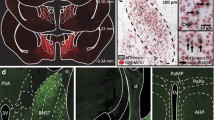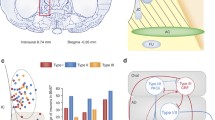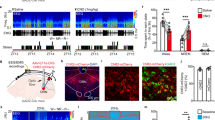Abstract
The transcription factor Nur77 has been identified as a neuronal activation marker of stressful stimuli in the central nervous system. Nur77 plays a key role at all levels of the hypothalamus–pituitary–adrenal axis during the stress response. However, the participation of Nur77 in extra-hypothalamic responses to stress is unknown. In this study, we studied the impact of acute and repeated immobilization stress on Nur77 expression in the bed nucleus of stria terminalis (BNST), a region involved in autonomic, neuroendocrine, and behavioral responses to stress. After a single session of immobilization stress we observed a significant increase of Nur77-like immunoreactivity in the BNST. This effect is not lost with repeated exposure to stress, since Nur77-like immunoreactivity and Nur77 mRNA in BNST were increased after the fifteenth stress session. The administration of desipramine, a specific inhibitor of noradrenaline reuptake, prevented the increase in Nur77-like immunoreactivity and mRNA induced by stress in rats subjected to repeated exposure to immobilization stress. Our results show that acute and repeated stress modulates Nur77 expression in BNST and suggest that Nur77 participates in extra-hypothalamic responses to stress.






Similar content being viewed by others
References
Andrés ME, Forray MI, Barría CG, Gysling K (1993) Studies of cholecystokinin in the rat bed nucleus of stria terminalis. Biochem Pharmacol 45:2283–2288
Bassett MH, White PC, Rainey WE (2004) A role for the NGFI-B family in adrenal zonation and adrenocortical disease. Endocr Res 30:567–574
Beaudry G, Langlois MC, Weppe I, Rouillard C, Levesque D (2000) Contrasting patterns and cellular specificity of transcriptional regulation of the nuclear receptor nerve growth factor-inducible B by haloperidol and clozapine in the rat forebrain. J Neurochem 75:1694–1702
Brownstein MJ, Palkovits M (1984) Catecholamines, serotonin, acetylcholine, and g-aminobutyric acid in the rat brain: biochemical studies. In: Bjorklund A, Hokfelt T (eds) Handbook of chemical neuroanatomy, Part I, vol 2. Elsevier, Amsterdam, pp 23–54
Cecchi M, Khoshbouei H, Javors M, Morilak DA (2002a) Modulatory effects of norepinephrine in the lateral bed nucleus of the stria terminalis on behavioral and neuroendocrine responses to acute stress. Neuroscience 112:13–21
Cecchi M, Khoshbouei H, Morilak DA (2002b) Modulatory effects of norepinephrine, acting on alpha 1 receptors in the central nucleus of the amygdala, on behavioral and neuroendocrine responses to acute immobilization stress. Neuropharmacology 43:1139–1147
Chan RK, Brown ER, Ericsson A, Kovács KJ, Sawchenko PE (1993) A comparison of two immediate-early genes, c-fos and NGFI-B, as markers for functional activation in stress-related neuroendocrine circuitry. J Neurosci 13:5126–5138
Choi DC, Furay AR, Evanson NK, Ostrander MM, Ulrich-Lai YM, Herman JP (2007) Bed nucleus of the stria terminalis subregions differentially regulate hypothalamic–pituitary–adrenal axis activity: implications for the integration of limbic inputs. J Neurosci 27:2025–2034
Crawford PA, Sadovsky Y, Woodson K, Lee SL, Milbrandt J (1995) Adrenocortical function and regulation of the steroid 21-hydroxylase gene in NGFI-B-deficient mice. Mol Cell Biol 15:4331–4336
Crestani CC, Alves FH, Resstel LB, Correa FM (2007) Cardiovascular effects of noradrenaline microinjection in the bed nucleus of the stria terminalis of the rat brain. J Neurosci Res 85:1592–1599
Crestani CC, Alves FH, Correa FM, Guimarães FS, Joca SR (2010) Acute reversible inactivation of the bed nucleus of stria terminalis induces antidepressant-like effect in the rat forced swimming test. Behav Brain Funct 6:30
Cummings S, Elde R, Ells J, Lindall A (1983) Corticotropin-releasing factor immunoreactivity is widely distributed within the central nervous system of the rat: an immunohistochemical study. J Neurosci 3:1355–1368
D’Aquila PS, Peana AT, Carboni V, Serra G (2000) Exploratory behaviour and grooming after repeated restraint and chronic mild stress: effect of desipramine. Eur J Pharmacol 399:43–47
Drouin J, Maira M, Philips A (1998) Novel mechanism of action for Nur77 and antagonism by glucocorticoids: a convergent mechanism for CRH activation and glucocorticoid repression of POMC gene transcription. J Steroid Biochem Mol Biol 65:59–63
Eells JB, Lipska BK, Yeung SK, Misler JA, Nikodem VM (2002) Nurr1-null heterozygous mice have reduced mesolimbic and mesocortical dopamine levels and increased stress-induced locomotor activity. Behav Brain Res 136:267–275
Fahrner TJ, Carroll SL, Milbrandt J (1990) The NGFI-B protein, an inducible member of the thyroid/steroid receptor family, is rapidly modified posttranslationally. Mol Cell Biol 10:6454–6459
Forray MI, Gysling K (2004) Role of noradrenergic projections to the bed nucleus of the stria terminalis in the regulation of the hypothalamic–pituitary–adrenal axis. Brain Res Brain Res Rev 47:145–160
Fu Y, Luo L, Luo N, Zhu X, Garvey WT (2007) NR4A orphan nuclear receptors modulate insulin action and the glucose transport system: potential role in insulin resistance. J Biol Chem 282:31525–31533
Fuentealba JA, Forray MI, Gysling K (2000) Chronic morphine treatment and withdrawal increase extracellular levels of norepinephrine in the rat bed nucleus of the stria terminalis. J Neurochem 75:741–748
Gavrilovic L, Spasojevic N, Zivkovic M, Dronjak S (2009) Effect of immobilization stress on gene expression of catecholamine biosynthetic enzymes in heart auricles of socially isolated rats. Braz J Med Biol Res 42:1185–1190
Gobshtis N, Ben-Shabat S, Fride E (2007) Antidepressant-induced undesirable weight gain: prevention with rimonabant without interference with behavioral effectiveness. Eur J Pharmacol 554:155–163
Harris RB, Mitchell TD, Simpson J, Redmann SM Jr, Youngblood BD, Ryan DH (2002a) Weight loss in rats exposed to repeated acute restraint stress is independent of energy or leptin status. Am J Physiol Regul Integr Comp Physiol 282:R77–R88
Harris RB, Zhou J, Mitchell T, Hebert S, Ryan DH (2002b) Rats fed only during the light period are resistant to stress-induced weight loss. Physiol Behav 76:543–550
Hazel TG, Nathans D, Lau LF (1988) A gene inducible by serum growth factors encodes a member of the steroid and thyroid hormone receptor superfamily. Proc Natl Acad Sci USA 85:8444–8448
Honkaniemi J, Sharp FR (1996) Global ischemia induces immediate-early genes encoding zinc finger transcription factors. J Cereb Blood Flow Metab 16:557–565
Honkaniemi J, Kononen J, Kainu T, Pyykonen I, Peltohuikko M (1994) Induction of multiple immediate-early genes in rat hypothalamic paraventricular nucleus after stress. Mol Brain Res 25:234–241
Imaki T, Shibasaki T, Chikada N, Harada S, Naruse M, Demura H (1996) Different expression of immediate-early genes in the rat paraventricular nucleus induced by stress: relation to corticotropin-releasing factor gene transcription. Endocr J 43:629–638
Invernizzi RW, Garattini S (2004) Role of presynaptic alpha2-adrenoceptors in antidepressant action: recent findings from microdialysis studies. Prog Neuropsychopharmacol Biol Psychiatry 28:819–827
Itoi K, Sugimoto N (2010) The brainstem noradrenergic systems in stress, anxiety and depression. J Neuroendocrinol 22:355–361
Katunar MR, Saez T, Brusco A, Antonelli MC (2009) Immunocytochemical expression of dopamine-related transcription factors Pitx3 and Nurr1 in prenatally stressed adult rats. J Neurosci Res 87:1014–1022
Katunar MR, Saez T, Brusco A, Antonelli MC (2010) Ontogenetic expression of dopamine-related transcription factors and tyrosine hydroxylase in prenatally stressed rats. Neurotox Res 18:69–81
Korosi A, Schotanus S, Olivier B, Roubos EW, Kozicz T (2005) Chronic ether stress-induced response of urocortin 1 neurons in the Edinger-Westphal nucleus in the mouse. Brain Res 1046:172–179
Kovács KJ, Sawchenko PE (1996) Sequence of stress-induced alterations in indices of synaptic and transcriptional activation in parvocellular neurosecretory neurons. J Neurosci 16:262–273
Kuwaki T (2010) Orexin links emotional stress to autonomic functions. Auton Neurosci. PubMed PMID: 20813590
Lam BY, Zhang W, Ng DC, Maruthappu M, Llewelyn Roderick H, Chawla S (2009) CREB-dependent Nur77 induction following depolarization in PC12 cells and neurons is modulated by MEF2 transcription factors. J Neurochem 112:1065–1073
Langnaese K, John R, Schweizer H, Ebmeyer U, Keilhoff G (2008) Selection of reference genes for quantitative real-time PCR in a rat asphyxial cardiac arrest model. BMC Mol Biol 9:53
Lévesque D, Rouillard C (2007) Nur77 and retinoid X receptors: crucial factors in dopamine-related neuroadaptation. Trends Neurosci 30:22–30
Liu B, Kwok RP, Fernstrom JD (1991) Colchicine-induced increases in immunoreactive neuropeptide levels in hypothalamus: use as an index of biosynthesis. Life Sci 49:345–352
Liu ZG, Smith SW, McLaughlin KA, Schwartz LM, Osborne BA (1994) Apoptotic signals delivered through the T-cell receptor of a T-cell hybrid require the immediate-early gene nur77. Nature 367:281–284
López-Rubalcava C, Lucki I (2000) Strain differences in the behavioral effects of antidepressant drugs in the rat forced swimming test. Neuropsychopharmacology 22:191–199
Lupien SJ, McEwen BS, Gunnar MR, Heim C (2009) Effects of stress throughout the lifespan on the brain, behaviour and cognition. Nat Rev Neurosci 10:434–445
Maheux J, Ethier I, Rouillard C, Lévesque D (2005) Induction patterns of transcription factors of the nur family (nurr1, nur77, and nor-1) by typical and atypical antipsychotics in the mouse brain: implication for their mechanism of action. J Pharmacol Exp Ther 313:460–473
Makino S, Gold PW, Schulkin J (1994) Effects of corticosterone on CRF mRNA and content in the bed nucleus of the stria terminalis; comparison with the effects in the central nucleus of the amygdala and the paraventricular nucleus of the hypothalamus. Brain Res 657:141–149
Mansi JA, Rivest S, Drolet G (1998) Effect of immobilization stress on transcriptional activity of inducible immediate-early genes, corticotropin-releasing factor, its type 1 receptor, and enkephalin in the hypothalamus of borderline hypertensive rats. J Neurochem 70:1556–1566
Martinez-Gonzalez J, Badimon L (2005) The NR4A subfamily of nuclear receptors: new early genes regulated by growth factors in vascular cells. Cardiovasc Res 65:609–618
Mateo Y, Pineda J, Meana JJ (1998) Somatodendritic alpha2-adrenoceptors in the locus coeruleus are involved in the in vivo modulation of cortical noradrenaline release by the antidepressant desipramine. J Neurochem 71:790–798
Maxwell MA, Muscat GE (2006) The NR4A subgroup: immediate early response genes with pleiotropic physiological roles. Nucl Recept Signal 4:e002
Milbrandt J (1988) Nerve growth factor induces a gene homologous to the glucocorticoid receptor gene. Neuron 1:183–188
Morilak DA, Barrera G, Echevarria DJ, Garcia AS, Hernandez A, Ma S, Petre CO (2005) Role of brain norepinephrine in the behavioral response to stress. Prog Neuropsychopharmacol Biol Psychiatry 29:1214–1224
Murphy EP, Conneely OM (1997) Neuroendocrine regulation of the hypothalamic pituitary adrenal axis by the nurr1/nur77 subfamily of nuclear receptors. Mol Endocrinol 11:39–47
Nankova BB, Fuchs SY, Serova LI, Ronai Z, Wild D, Sabban EL (1998) Selective in vivo stimulation of stress-activated protein kinase in different rat tissues by immobilization stress. Stress 2:289–298
Neumann-Haefelin T, Wiessner C, Vogel P, Back T, Hossmann KA (1994) Differential expression of the immediate early genes c-fos, c-jun, junB, and NGFI-B in the rat brain following transient forebrain ischemia. J Cereb Blood Flow Metab 14:206–216
Nobrega JN, Coscina DV (1987) Effects of chronic amitriptyline and desipramine on food intake and body weight in rats. Pharmacol Biochem Behav 27:105–112
Ohkura N, Ito M, Tsukada T, Sasaki K, Yamaguchi K, Miki K (1996) Structure, mapping and expression of a human NOR-1 gene, the third member of the Nur77/NGFI-B family. Biochim Biophys Acta 1308:205–214
Pacak K, McCarty R, Palkovits M, Kopin IJ, Goldstein DS (1995) Effects of immobilization on in vivo release of norepinephrine in the bed nucleus of the stria terminalis in conscious rats. Brain Res 688:242–246
Parkes D, Rivest S, Lee S, Rivier C, Vale W (1993) Corticotropin-releasing factor activates c-fos, NGFI-B, and corticotropin-releasing factor gene expression within the paraventricular nucleus of the rat hypothalamus. Mol Endocrinol 7:1357–1367
Paxinos G, Watson C (1997) The rat brain in stereotaxic coordinates, 3rd edn. Academic Press, San Diego
Pego JM, Morgado P, Pinto LG, Cerqueira JJ, Almeida OFX, Sousa N (2008) Dissociation of the morphological correlates of stress-induced anxiety and fear. Eur J Neurosci 27:1503–1516
Pei L, Waki H, Vaitheesvaran B, Wilpitz DC, Kurland IJ, Tontonoz P (2006) NR4A orphan nuclear receptors are transcriptional regulators of hepatic glucose metabolism. Nat Med 12:1048–1055
Pfaffl MW (2001) A new mathematical model for relative quantification in real-time RT-PCR. Nucleic Acids Res 29:e45
Phelix CF, Liposits Z, Paull WK (1992) Monoamine innervation of bed nucleus of stria terminalis: an electron microscopic investigation. Brain Res Bull 28:949–965
Philips A, Maira M, Mullick A, Chamberland M, Lesage S, Hugo P, Drouin J (1997) Antagonism between Nur77 and glucocorticoid receptor for control of transcription. Mol Cell Biol 17:5952–5959
Rivest S, Rivier C (1994) Stress and interleukin-1-beta-induced activation of c-Fos, NGFI-B and CRF gene expression in the hypothalamic PVN comparison between Sprague–Dawley, Fisher-344 and Lewis rats. J Neuroendocrinol 6:101–117
Rojas P, Joodmardi E, Hong Y, Perlmann T, Ogren SO (2007) Adult mice with reduced Nurr1 expression: an animal model for schizophrenia. Mol Psychiatry 12:756–766
Rojas P, Joodmardi E, Perlmann T, Ogren SO (2010) Rapid increase of Nurr1 mRNA expression in limbic and cortical brain structures related to coping with depression-like behavior in mice. J Neurosci Res 88:2284–2293
Santibañez M, Gysling K, Forray MI (2006) Desipramine prevents the sustained increase in corticotropin-releasing hormone-like immunoreactivity induced by repeated immobilization stress in the rat central extended amygdala. J Neurosci Res 84:1270–1281
Saucedo-Cardenas O, Conneely OM (1996) Comparative distribution of NURR1 and NUR77 nuclear receptors in the mouse central nervous system. J Mol Neurosci 7:51–63
Shalizi A, Gaudillière B, Yuan Z, Stegmüller J, Shirogane T, Ge Q, Tan Y, Schulman B, Harper JW, Bonni A (2006) A calcium-regulated MEF2 sumoylation switch controls postsynaptic differentiation. Science 311:1012–1017
Shepard JD, Schulkin J, Myers DA (2006) Chronically elevated corticosterone in the amygdala increases corticotropin releasing factor mRNA in the dorsolateral bed nucleus of stria terminalis following duress. Behav Brain Res 174:193–196
St-Hilaire M, Landry E, Lévesque D, Rouillard C (2005) Denervation and repeated L-DOPA induce complex regulatory changes in neurochemical phenotypes of striatal neurons: implication of a dopamine D1-dependent mechanism. Neurobiol Dis 20:450–460
Stout SC, Mortas P, Owens MJ, Nemeroff CB, Moreau J (2000) Increased corticotropin-releasing factor concentrations in the bed nucleus of the stria terminalis of anhedonic rats. Eur J Pharmacol 401:39–46
Suvrathan A, Tomar A, Chattarji S (2010) Effects of chronic and acute stress on rat behaviour in the forced-swim test. Stress 13:533–540
Svenningsson P, Nomikos GG, Fredholm BB (1995) Biphasic changes in locomotor behavior and in expression of mRNA for NGFI-A and NGFI-B in rat striatum following acute caffeine administration. J Neurosci 15:7612–7624
Szarek BL, Brandt DM (1993) A comparison of weight changes with fluoxetine, desipramine, and amitriptyline: a retrospective study of psychiatric inpatients. J Nerv Ment Dis 181:702–704
Thal SC, Wyschkon S, Pieter D, Engelhard K, Werner C (2008) Selection of endogenous control genes for normalization of gene expression analysis after experimental brain trauma in mice. J Neurotrauma 25:785–794
Trnecková L, Rotllant D, Klenerová V, Hynie S, Armario A (2007) Dynamics of immediate early gene and neuropeptide gene response to prolonged immobilization stress: evidence against a critical role of the termination of exposure to the stressor. J Neurochem 100:905–914
Umemoto S, Kawai Y, Senba E (1994) Differential regulation of IEGs in the rat PVH in single and repeated stress models. Neuroreport 6:201–204
Umemoto S, Kawai Y, Ueyama T, Senba E (1997) Chronic glucocorticoid administration as well as repeated stress affects the subsequent acute immobilization stress-induced expression of immediate early genes but not that of NGFI-A. Neuroscience 80:763–773
von Hertzen LS, Giese KP (2005) Memory reconsolidation engages only a subset of immediate-early genes induced during consolidation. J Neurosci 25:1935–1942
Vyas A, Bernal S, Chattarji S (2003) Effects of chronic stress on dendritic arborization in the central and extended amygdala. Brain Res 965:290–294
Walker DL, Toufexis DJ, Davis M (2003) Role of the bed nucleus of the stria terminalis versus the amygdala in fear, stress, and anxiety. Eur J Pharmacol 463:199–216
Walker DL, Miles LA, Davis M (2009) Selective participation of the bed nucleus of the stria terminalis and CRF in sustained anxiety-like versus phasic fear-like responses. Prog Neuropsychopharmacol Biol Psychiatry 33:1291–1308
Werme M, Ringholm A, Olson L, Brene S (2000) Differential patterns of induction of NGFI-B, Nor1 and c-fos mRNAs in striatal subregions by haloperidol and clozapine. Brain Res 863:112–119
Woronicz JD, Calnan B, Ngo V, Winoto A (1994) Requirement for the orphan steroid receptor Nur77 in apoptosis of T-cell hybridomas. Nature 367:277–281
Zhang SJ, Steijaert MN, Lau D, Schutz G, Delucinge-Vivier C, Descombes P, Bading H (2007) Decoding NMDA receptor signaling: identification of genomic programs specifying neuronal survival and death. Neuron 53:549–562
Acknowledgments
This study was supported by FONDECYT Projects 3085027 (DCM) and 1070349 (MEA) and Millennium Nucleus in Stress and Addiction MSI N° P06/008-F. We acknowledge Mr. Elias Blanco for his support in confocal microscopy.
Author information
Authors and Affiliations
Corresponding author
Rights and permissions
About this article
Cite this article
Campos-Melo, D., Quiroz, G., Noches, V. et al. Repeated Immobilization Stress Increases Nur77 Expression in the Bed Nucleus of the Stria Terminalis. Neurotox Res 20, 289–300 (2011). https://doi.org/10.1007/s12640-011-9243-1
Received:
Revised:
Accepted:
Published:
Issue Date:
DOI: https://doi.org/10.1007/s12640-011-9243-1




